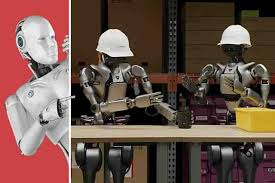ChatGPT-like breakthrough in humanoid robotics expected in 2-3 years, says Vinod Khosla

In a bold prediction that could reshape the future of everyday life, renowned venture capitalist Vinod Khosla has stated that humanoid robots are just 2 to 3 years away from their own “ChatGPT moment.” Drawing parallels to the rapid rise of large language models like ChatGPT, Khosla believes that humanoid robots—machines that can learn, adapt, and perform tasks in real-world settings—are on the brink of a breakthrough that will bring them into homes and businesses at scale.
A Parallel to the AI Revolution
When ChatGPT launched in late 2022, it marked a watershed moment in artificial intelligence. Suddenly, everyday users could interact with a machine that could write essays, answer complex questions, generate code, and simulate intelligent conversation with remarkable ease. For many, it felt like stepping into the future.
Vinod Khosla now envisions a similar leap in robotics. He suggests that within the next few years, we’ll see robots that don’t just follow simple pre-programmed commands but that can learn from their environments, understand nuanced human instructions, and adapt to new tasks just like ChatGPT adapts to questions in conversation.
“We’re going to have a ChatGPT moment for robotics, and it’s coming fast,” Khosla said in a recent interview.
This statement signals that robotics, especially in the field of humanoid robots, could become the next frontier where AI visibly transforms human lives.
From Research Labs to Your Kitchen
While robots have long been present in industrial settings—building cars, packing boxes, or sorting inventory—their transition into human spaces like homes has been slow. That’s changing quickly.
According to Khosla, the initial wave of humanoid robots will likely focus on narrow household tasks. Imagine a robot that can:
- Chop vegetables.
- Load the dishwasher.
- Clean countertops.
- Cook simple meals.
These aren’t science-fiction scenarios anymore. Multiple startups and AI labs are working on embodied intelligence, teaching machines to understand physical spaces and manipulate real-world objects. Combined with advanced sensors and neural networks, these robots won’t just be glorified vacuum cleaners—they’ll understand context and purpose.
Learning, Not Just Repeating
One of the defining features of these upcoming robots is that they won’t be limited to rigid, pre-scripted movements. Instead, they’ll function using general intelligence, allowing them to adapt to dynamic environments.
For example, if you tell a future home robot: “Clean the kitchen,” it won’t require step-by-step instructions. It will interpret the goal, scan the environment, recognize dirty dishes, clutter, or spills—and figure out the right sequence of actions.
This ability to reason, plan, and execute complex tasks is what Khosla compares to ChatGPT’s language prowess.
Affordability and Accessibility
Khosla also makes a critical point about cost. He predicts these home-use robots could be available for as little as $300–400 per month, making them an alternative to human domestic help in many households.
This pricing strategy could make robotics more accessible than ever, especially in countries with growing middle classes, aging populations, and rising demand for assistance in everyday tasks.
At this rate, robots might soon become as commonplace in homes as smartphones or dishwashers.
A Surge in Industry Momentum
Khosla’s view isn’t a lonely one. The broader AI and tech ecosystem is increasingly aligning behind the idea that “physical AI”—intelligent machines that can interact with the world—is the next wave of innovation.
- NVIDIA’s CEO Jensen Huang has spoken about “personal droids” becoming real in the next decade.
- NVIDIA is already building the tools—like the Isaac robotics platform and Jetson Thor chips—to power these machines.
- Startups like Figure AI, 1X Technologies, and Sanctuary AI are racing to build general-purpose humanoid robots.
- Even Amazon, Tesla, and Agility Robotics are investing heavily in physical automation powered by AI.
As computing hardware gets more powerful, and machine learning systems become more capable, the ability to teach machines to interact with the physical world is improving rapidly.
Startups Will Lead the Charge
Perhaps most significantly, Khosla emphasizes that startups will likely drive this revolution—not giant tech corporations. He compares the opportunity to past disruptors like Uber, Airbnb, and Netflix, who upended entire industries by doing things differently.
Startups, he argues, are better positioned to take bold bets and iterate quickly. They can experiment with form factors, use cutting-edge AI models, and bring truly novel experiences to users—just as OpenAI did with ChatGPT.
Khosla Ventures has already backed some of these companies, betting that humanoid robotics will be a core part of the future.
Social and Ethical Implications
As exciting as these developments sound, they also raise serious questions:
- Will humanoid robots displace millions of workers in domestic and service jobs?
- How do we ensure they operate safely in human environments?
- Who is responsible when a robot makes a mistake?
These questions aren’t theoretical. As robots become capable of more tasks, clear policies and safety standards will be essential.
Moreover, developers must ensure that humanoid robots respect privacy, avoid bias, and remain secure from hacking or manipulation.
What Happens Next?
If Khosla’s prediction holds, the world could look very different by 2027 or 2028. Imagine walking into a friend’s home and being greeted by a humanoid robot that can cook, clean, and learn your preferences.
It’s not science fiction anymore. With AI reaching new heights and robotics catching up fast, the line between machine intelligence and physical ability is fading.
We may soon look back at this era the way we now look at 2022’s AI boom—the quiet before the robot storm.






